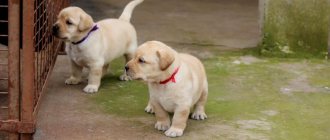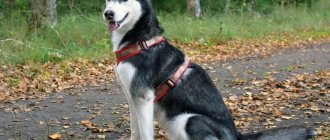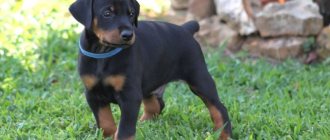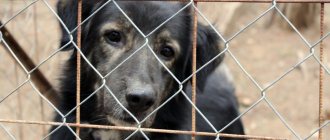Why are dogs given bones to chew on, whether they are healthy or not?
As a food product, they are ineffective for dogs. They are low in calories, are absorbed by the body very poorly, and domestic dogs are simply unable to digest most of them. Even well-cooked bones are dangerous for the animal. When eaten, they are crushed by the teeth; a large number of them can cause intestinal blockage. It’s good if you get by with treatment - laxatives, enemas, etc. If the course is unfavorable, this is surgery. But when purchasing a puppy, many owners immediately have a picture in their head of a dog chewing on a bone. So can dogs be given bones?
It is worth noting that they are suitable for making broth, especially large beef moles. An excellent porridge is then prepared using the broth. These bones contain a lot of cartilage tissue, collagen fibers, and meat remains. This is why dogs love to chew bones - because of their usefulness - collagen and cartilage. Usually these products rarely come to them in their pure form and instincts are triggered. Dogs readily gnaw them. The bone itself remains almost intact. This eliminates known risks.
Arguments against
- Once upon a time, a dog was a wild animal and it definitely needed solid food, and even today a healthy gastrointestinal tract and teeth need it, but in addition to bones, there is also dry food and vegetables. In addition, modern breeds no longer have such a strong stomach, and it is worth recognizing that animals in the wild lived much less than our pets, including because the intestines became clogged with bone fragments and various debris.
- With “weak” teeth, when a dog chews on a bone, the enamel is worn down, and there is a risk of breaking off the canines or incisors.
- Raw bones can be dangerous for dogs because they can become infected with viruses or parasites. And due to pathogenic bacteria, the dog can simply become poisoned or contract an intestinal infection.
- Risk of suffocation - a piece of bone may block the windpipe.
- Injury to the soft tissues of the oral cavity and trachea. Sharp or broken edges of the bone scratch and cut the mucous membrane, leading to bleeding.
- Intestinal obstruction - bone fragments get stuck in a certain part of the intestine and cannot move further. Such accumulation irritates the intestines and can cause bleeding, in which case surgical intervention is already necessary.
At what age can a puppy eat a bone?
Can I give my puppy bones? Only veal ones, namely the shoulder blade with cartilage, the breast bone and pseudoribs. They contain a lot of chondrin and collagen.
It is recommended to introduce it into the diet from 3 months. After the start of the process of changing teeth. They are not suitable as main food. Can be used as a toy with a pleasant taste from 2 months. It is important to ensure that there are no chips on the bone that could injure your pet. The edges should be round and not damaged. Problems can arise if the animal eats a small bone. A whole, rounded bone with remnants of cartilage and ligaments will benefit the puppy. Especially when his teeth change, he will chew on it, not the furniture.
Older individuals can be given milk from 1-2 year old bulls or calves.
Who can't?
Dogs that eat commercial food should not be given bones. The acidity in their stomachs is altered so they will not be able to digest, which usually results in vomiting. The health and life of the animal is in danger in this case.
If your pet eats a mixed diet and his diet alternates between dry food and canned food and meat, then you should not give him bones either.
For pets who suffer from diseases of the gastrointestinal tract and take the drug omez, this type of product in the diet is contraindicated.
Pregnant females fed raw foods should not be given bones during the last weeks of pregnancy.
During the period when mothers begin to feed their puppies, bones should be completely excluded from their diet.
Which animal bones can be given and which ones cannot?
Let's find out what bones can be given to dogs, and why?
Beef
The bones of old cows are yellowish and have a lot of beef fat on them. The bones of young individuals are white and practically free of fat. Here's what to remember when going to the market. Pseudo-ribs, sternum, and shoulder blade are excellent. Medium and large breeds love the ridge. Bones also include calf heads. When boiled, this is an excellent dish for a dog. There is meat from the chewing muscles (cheeks), facial muscles, lips, nostrils, nasal septum (cartilage), and brain. It is important to pick off the wool after cooking. It comes off easily. Don't pluck, but kind of roll it up. Before cooking, cut the head in half along the axis of the skull. Tarring is not recommended - the burning smell will remain.
Pork
These bones, like the pork itself, are very fatty. In addition, they are porous, because they slaughter mainly young individuals. Dogs eat such bones almost completely. Is it possible to give a dog pork bones with these characteristics? No. It is worth noting that the pork snout consists of cartilage, muscle and skin. You can give it raw 1-2 times a week. Freeze before feeding!
Chicken
Bird bones should not be given to dogs at all. And here's why dogs shouldn't be given chicken bones. They are thin, soft, have a lot of meat and cartilage left on them, and dogs willingly eat them. If they simply gnaw off large beef bones and leave the bones themselves, then birds can eat large quantities (necks, wings, skeletons, heads) and completely. This is very harmful and dangerous. The very quality of the bones, like broiler chicken from the factory, is questionable.
Although many people recommend chicken necks even abroad (BARF) without fear of anything, not even allergies.
Turkey
Turkey bones differ from chicken bones only in size. All recommendations will be the same as for chicken bones.
A rabbit
Rabbit bones are very small and have many tubular bones. As a delicacy, the backbone and pelvis can be given to large dogs. Infrequently. The head deserves special attention; most dogs do not eat the teeth and leave them alone.
Lamb
These bones, like veal bones, are very good. But you should take the same precautions as with other bones for your animal. It is not recommended to use them as the basis of your diet.
Elk, roe deer, wild boar
They must be frozen deeply and then be sure to be thoroughly boiled. The threat of trichinosis is much higher. Considering the risks, each owner decides for himself. If you choose them, then follow the same recommendations as described above.
Bones as a nutrient
If the dog is fed on the BARF diet, then the basis of the menu is raw bones with meat. In addition to them, the dog receives protein food (dairy products, offal, eggs, fish), dietary fiber and sugar (vegetables and fruits) and fats (oils).
BARF has two meanings: "bones and raw food" or "organic raw food". Thus, the BARF concept is based on feeding the dog only raw food, and individual nutrients must take into account the evolutionary diet. This, in turn, is optimal for the genetic characteristics of each species in nature, and according to the creators of BARF, a dog on this diet can live in health and wellness longer than if it were fed otherwise.
A properly prepared BARF meal should include:
60 percent - raw bones with meat; 15 percent - vegetables; 10 percent - by-products (liver, heart, kidneys, lungs, spleen); 10 percent - eggs, dairy products, butter, cottage cheese, fish; 5 percent - fruits.
BARF Diet ingredients should only come from trusted sources. Meat and offal from young, healthy animals can be frozen in portions and used as needed. It may happen that a dog (especially a very young or old one) becomes constipated after eating bones, then grinding them would be justified.
Bones are not given to dogs that are fed only cooked food and balanced dry food.
Artificial bones for strengthening and cleaning teeth - benefits and harms
Chewable (gelatin)
They are a safe toy. Puppies readily gnaw on it when changing teeth. Manufacturers produce for specific breed groups. But it is not always clear how chewing bones for dogs are produced; here it is also worth choosing a manufacturer, keeping an eye on his reputation. Excessive feeding is fraught with gastrointestinal problems.
Rubber
They are a simple toy for your pet like a ball, rubber pig or chicken. Great for leisure time. When choosing in a store, it is recommended to ask for a certificate of quality and safety of a rubber product. The choice of color and size is yours.
Pressed from veins (tendons)
The most useful type of artificial seed. They are more expensive, but they also provide more benefits. They contain natural chondrin. It is very useful for puppies and adult animals. It is important not to overfeed the animal with this product. Dogs love him very much. This is becoming one of my favorite treats. The veins in them are steamed and crushed before pressing. They are safe, but in large quantities they will become harmful.
Industrial bones
Solid dog treats from the pet store are the answer for many breeders. They are inexpensive and sold everywhere.
A pet eating dry food should not eat natural offal. The acidity in the stomach will not be able to digest them, especially long bone. For such dogs, only industrial analogues are preferred.
There are several types of artificial seeds:
- Calcium. Form and maintain tooth enamel. Help older dogs keep their musculoskeletal system healthy and strong. The packaging indicates the weight of the animal and the required amount of product. Large individuals are given one piece per day, miniature ones are divided into several parts.
- From tendons. Suitable for additional teeth cleaning. The composition of the product is completely natural. Bones are given to dogs with allergies. They do not cause a reaction in the body. Puppies who indulge in such treats can spend several hours eating.
- Chewable. Not suitable for dogs under 4 months. The owner should carefully read the instructions.
- Gelatin. They remove food debris, maintain healthy tooth enamel, and distract the dog while waiting for the owner. Bones are an additional source of collagen. Some representatives of the pet industry add vitamins and minerals to the composition. Zoologists give them to pregnant dogs to keep fit.
- Chicken. An ideal analogue to natural bones. The taste of the product is indistinguishable from natural.
Store-bought treats can also be dangerous for dogs, especially small ones. Unchewed pieces get stuck in the throat, causing suffocation. If such an incident occurs, the owner must take the dog in his arms, talk to him calmly and affectionately, open his mouth, and remove the foreign object. The main thing is not to panic and maintain composure. In this case, no one except a person can save the four-legged animal.
Benefits of production seeds:
- When changing teeth, the puppy experiences discomfort and itching in the mouth. Solid treats make teething easier;
- Your teeth will be clean and strong, your gums will be healthy;
- One seed contains a large amount of vitamins and minerals.
Small dogs should not be left alone with treats. Despite the fact that the manufactured analogue is softer than the natural one, the puppy’s undeveloped muscles are not able to thoroughly chew solid food.
Which dog breeds can be fed bones and which cannot?
It is recommended to give high quality natural bones to medium and large breeds, but only as a treat. You can give them to puppies when they change teeth, as a tasty toy.
Small breeds do not have such physical characteristics and bones are contraindicated for them. Such dogs often have problems with teeth - another reason for the disadvantage of giving a bone. The pet industry produces various artificial options for them. It is very good sometimes to give a pressed look from veins of the appropriate size. Gelatin ones are less nutritious.
Chicken
Chicken bones for dogs, however, like any other animal origin, according to veterinary specialists and experienced dog breeders, should not be given to four-legged pets. This is not the safest option. Natural bones often provoke diarrhea, bleeding, gastritis, and ulcerative lesions of the digestive tract in animals.
In severe cases, bone fragments can lead to intestinal blockage and gastric volvulus. The best option would be to replace a natural product with an artificial analogue. Among the numerous variety of industrial treats, a caring owner can easily find an artificial chicken-flavored treat for a picky pet.
Watch this video about the benefits of rawhide bones for dogs:
[custom_ads_shortcode1]
Possible dangerous consequences
When a dog eats bones, it chews them into small pieces. But it is very difficult for the body to digest them. A semi-digested porous mass accumulates. The consequence is difficulty in excreting feces and the appearance of blood. If the bones continue to be absorbed in the same quantity, the intestines become clogged. If you contact a veterinarian in time, you can get by with a deep enema and a laxative. Then you will need a strict diet.
If the blockage is so large that it cannot be washed out, or there are several foci, there is only one way out - surgery. An ultrasound will show everything. In a critical case, necrosis of the intestinal wall may occur due to circulatory problems. This applies to everyone, even dogs of the largest breeds. If the outcome of the operation is favorable, rehabilitation lasts quite a long time.
It is much more dangerous when a sharp piece of bone pierces the intestines or stomach, and sometimes in several places (the intestines are laid out in loops). The likelihood of peritonitis is very high. Surgery is inevitable. Treatment will include very powerful antibiotics.
Older dogs may have dental problems. Bones carry a high load on them.
A pet can also choke on a piece of bone, but this happens extremely rarely.
What is the danger?
Some people consider bones to be an empty and useless toy for dogs, others believe they are an excellent “calming medicine” - a dog gnawing a callus is distracted from stress factors. Another negative aspect is that dogs often grind their teeth down on hard bone, and gastric juice is produced in an empty stomach. This may cause heartburn. But that’s not the main danger (and neither is the dignity – a bone won’t cure a dog of neurosis).
Very often, dogs are brought to the veterinary clinic with various types of injuries received when the animal chewed a bone. If it is extremely difficult for a dog to chew a hard callus, then small bones may not be able to withstand strong teeth, and sharp fragments can dig into the esophagus, stomach, and intestines, which will cause damage and dangerous internal bleeding. It is for this reason that pets (both cats and dogs) should not be given bones:
- Chicken;
- duck, goose, turkey;
- a rabbit;
- fish.
Broken pieces or bones can block the windpipe, damage the mucous membranes of the mouth, or clog the intestines in the trachea - and this is already a life-threatening condition for the animal. Immediate surgical intervention is required, since the dog can die from intestinal obstruction.
Another danger is peritonitis, inflammation of the abdominal cavity caused by damage to the digestive tract by sharp fragments. Its symptoms are:
- refusal to eat;
- lethargic, depressed state;
- vomit;
- sudden weight loss;
- heat;
- increased thirst;
- increase in daily urine volume;
- abdominal pain.
Local peritonitis (inflammation of a small area) caused by injury to the abdominal organs, with timely contact with a veterinarian, is successfully treated and progresses to general peritonitis and doctors often give very cautious prognoses for recovery.
What bones do dogs like and why?
Sugar brains
These are large, juicy bones of young farm animals. They are white in color, and the bone tissue of the trochanters is relatively soft and well saturated with blood vessels. A lot of bone marrow. They are quite easy to chew. The amount of cartilage tissue is high and it is easily separated from the bone body. The porous structure of skewers is easily digested by large dogs and is not visible in feces. Problems may arise with constant feeding.
Beef ribs with leftover meat
The intercostal muscles are very nutritious and pleasant to the taste. Animals willingly eat the ribs themselves whole (young farm animals). This is especially true for pseudo-edges.
With cartilage
Cartilage tissue carries a large amount of collagen and chondrin to the dog. It is a building material for joints and tendons. It is useful for growing cheeks, for adults to maintain shape, and for elderly people for prevention. They are loved by all categories. Most of the cartilage is on the sternum, pseudoribs (outer ribs not fused to the sternum), and shoulder blades. There is a lot of cartilaginous tissue in veal heads and pig snouts.
What to do if your dog swallows or chokes on a bone
Unfortunately, not always even such a harmless, at first glance, product as tendon bones may turn out to be safe for a four-legged scoundrel. In the practice of veterinary specialists, there are often cases when a dog swallows a bone or it gets stuck in the throat.
First of all, the owner should not lose composure and remain calm. It is necessary to make sure that the bone is actually in the respiratory tract. To do this, you need to calm the dog down, open its mouth and, using a flashlight, check for the presence of a foreign object.
If a small dog has a stuck bone, you can grab it by the hind legs and hold it there for a few minutes. In a critical situation, the owner can make 4-5 jerking movements in the area of the pet's diaphragm. You should not try to remove the bone from your dog's mouth with your hands.
Inept actions can lead to the fact that a foreign body further injures the animal . The best option in this situation would be to immediately contact a specialized institution.
If a dog is choking on a bone, the first thing a veterinarian will do is examine the pharynx and airways using a special device with a light. If a foreign object is found, a professional will remove it with long forceps. In some cases, endoscopic equipment comes to the rescue.
To avoid health problems, veterinary experts do not recommend giving your miniature pet bones for large dogs. Inconsistency in size can lead to the dog choking on a large treat.
We recommend reading about how to understand why a dog is choking. From the article you will learn about why a dog chokes after barking, when drinking water, coughing and more, how to help your pet. And here is more information about what to do if you suspect a foreign body in a dog.
The variety of artificial treats allows you to choose the best option, taking into account the age, size, and taste preferences of your four-legged pet. Bones for dogs help not only in the fight against boredom, but also strengthen the jaws, get rid of food debris, and prevent the deposition of tartar.
Many manufacturers fortify gelatin treats with vitamins and minerals. Such products can serve as a source of useful substances and be used for training your pet. If a dog chokes on a bone, it must be taken to a veterinary facility immediately.
[custom_ads_shortcode2]
Useful tips for introducing bones into the diet depending on the breed
Such:
- Puppies should be given bones from the moment their teeth begin to change.
- The bones must be of young farm animals and frozen.
- Chips and sharp edges are not allowed.
- Give bones 2-3 times a week.
- They are not suitable as the basis of a diet.
- The most useful are brisket, pseudoribs, veal heads (boiled).
- Chicken bones are extremely dangerous (necks are an exception).
- Natural bones are not recommended for small breeds.
- Of the artificial ones, the most useful are the pressed veins. Gelatin ones are just a treat. Rubber - a toy.
- The bones must be fresh, from young farm animals, white and free of fat.
More benefits
But that is not all. Some artificial bones for dogs not only perform a playful and entertaining function, but also have a positive effect on the health of the pet.
We are talking about X-shaped bones for caring for the oral cavity (for example, Pedigree DentaStix). Their specific shape helps the dog, while chewing the product, simultaneously brush his teeth, removing plaque from them even where a toothbrush may not reach. Another advantage of such treats is that they contain special components that prevent the formation of tartar. The bottom line from all this is this: artificial bones are the best and safest way to satisfy your dog's urge to chew on something. Moreover, some of them are capable of performing hygiene procedures, which only increases the value and benefit of such products.
Improper feeding of an animal can lead to dangerous consequences, including injury to internal organs. The dog may swallow a sharp bone fragment that can damage the throat or become lodged in it, blocking the airway.
[custom_ads_shortcode2]
Are bones beneficial or harmful?
Disputes about the benefits or harms of a product do not subside; supporters of one point of view or another provide many arguments. Let's highlight the pros and cons of the presence of bones in feeding a dog:
| Benefit | Harm |
|
|
All of these consequences are the result of improperly selected bones or too frequent introduction of them into the diet. For an adult dog, it is enough to feed raw food 1 or 2 times a week.
If a dog is pursuing a show career, bones are strictly contraindicated. There may be a change in the bite or appearance of the teeth.











